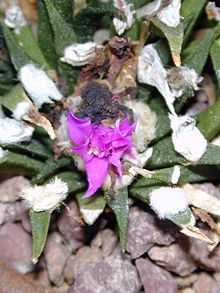Ariocarpus agavoides
| Ariocarpus agavoides | |
|---|---|
 | |
| Conservation status | |
| Scientific classification | |
| Kingdom: | Plantae |
| (unranked): | Angiosperms |
| (unranked): | Eudicots |
| (unranked): | Core eudicots |
| Order: | Caryophyllales |
| Family: | Cactaceae |
| Genus: | Ariocarpus |
| Species: | A. agavoides |
| Binomial name | |
| Ariocarpus agavoides (Castañeda) E.F.Anderson | |
Ariocarpus agavoides (also called Tamaulipas Living Rock Cactus) is a species of plant in the Cactaceae family. It is endemic to Mexico. Its natural habitat is hot deserts.
| Wikimedia Commons has media related to Ariocarpus agavoides. |
This cactus is collected and chewed by young children because of the sweet taste.
Description
The Ariocarpus agavoides is a small rosette shaped plant that is succulent and has short stiff, dark green tubercles. The stem is sub-globose greenish brown and flattened. The stems range from 2 to 6 cm in length and 4 to 8 cm in diameter. These stems just barely reach past the ground level. The rest of the plant is in the shape of a swollen rootstock and it stays under the ground. The tubercles on the plant are divergent and flaccid they are not erect, crowded, or basally compressed in any way. The stems are acute on the tips and do not have any grooves on them. They are flattened adaxially and do not curve inwards. The stems can measure from 3 to 7 cm long and are approximately 5 to 10 mm wide. They are more than 4 times long as they are wide. The A. agavoides has aeroles that measure 5-12mm and that are formed on the tip of the tubercles. They are rounded and approximately 2 to 5 mm in diameter. This cactus rarely is seen with spines, however it can develop some whitish spines that are about 2 to 10 mm long. This plant grows magenta flowers after around 5 to 8 years. These flowers are 3.5 to 4.2 cm in diameter and 2 to 5 cm long. It is entirely magenta on the outside with greenish-white margins. The inner parts are a darker magenta colour. The Pistils are a deep yellow, while the white stamens are raised 2 to 3mm from the pistils. The fruit of the A. agavoides is a globose and elongated pinkish-red to reddish purple colour that is 10 to 22mm long and 5 to 12 mm in diameter.
Habitat and Distribution
The A. agavoides has a very specific distribution which is situated only on the rocky limestone hills and at a height of around 1200m on the alluvial plains of Tula, Tamaulipas in Mexico. Many of the populations have been threatened by external factors such as over-collecting, agriculture, building work, livestock and erosion. Even with so few populations, the plant can still be found in this location, which says something about its resilience. Two new colonies have also been added since that time in San Luis Potosí which will help the thriving wild population of A. agavoides.
Conservation Actions
This cactus is classified as vulnerable (IUCN 3.1) and is listed on CITES Appendix I. It is illegal to collect the A. agavoides in Mexico as it is protected by the state under the national list of species at risk of extinction, NOM-059-SEMARNAT-2010. Despite the restriction, it still shows up in the trade market.
References
- Anderson, E.F., Fitz Maurice, W.A., Fitz Maurice, B., Sotomayor, M., Arrendondo, A.G. & Sánchez, B. 2002. Ariocarpus agavoides. 2006 IUCN Red List of Threatened Species. Downloaded on 20 August 2007.
- "Ariocarpus agavoides". http://www.cactus-art.biz''. Retrieved 13 March 2014.
- "Acriocarpus agavoides". http://www.living-rocks.com/''. 1962. Retrieved 13 March 2014.
